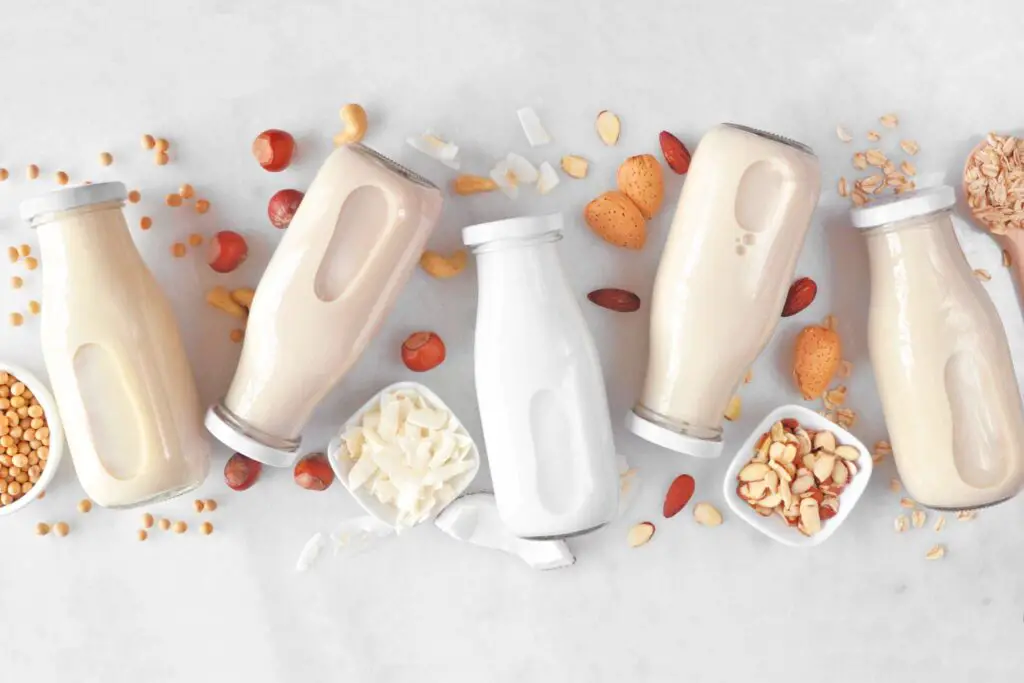Do you love coffee but want to cut back on dairy? Almond milk might be the perfect solution for you! Not only is it a tasty and creamy alternative, but it’s also a healthier option. But before you head to the store and grab the first carton of almond milk you see, you should know a few things. From choosing the right brand to making sure it doesn’t curdle in your coffee, here’s everything you need to know about using almond milk as a dairy-free option for your daily cup of joe.
Introduction To Almond Milk And Its Benefits

Almond milk has become a popular alternative to dairy milk in recent years, especially when it comes to coffee. This plant-based milk is made by blending ground almonds with water, resulting in a nutty and slightly sweet taste. Almond milk is low in calories and devoid of cholesterol, making it a healthier option for coffee drinkers who want to reduce their calorie intake.
Almond milk provides a delicious and nutritious alternative to traditional milk-based coffee drinks when combined with coffee. It is also a good source of vitamin E, calcium, and potassium, which are essential for maintaining good health. Studies have shown that consuming almond milk may help reduce the risk of heart disease and lower cholesterol levels.
People who are lactose intolerant or have a dairy allergy can also benefit from almond milk, which is free from lactose and dairy proteins. It is an excellent vegan alternative to traditional milk-based coffee drinks, making it a popular choice for those who follow a plant-based diet.
Overall, almond milk is a healthy and delicious option for coffee lovers who want to try something new. It adds a nutty and slightly sweet flavor to coffee, making it an excellent alternative to traditional dairy milk. With its many health benefits and growing popularity, almond milk is certainly worth considering for your next cup of coffee.
Differences Between Almond Milk And Dairy Milk
1. Nutrition: Dairy milk provides eight times more naturally-occurring protein than almond milk per 8-ounce glass. Dairy milk also contains no added sugar, while many brands of almond milk contain added sugar.
2. Almond Content: Many brands of almond milk may contain as little as 2% almonds, equivalent to 3 to 4 whole almonds in each 8-ounce glass. This is due to the amount of protein almonds contain, explaining the percentage of almonds to other ingredients in almond milk.
3. Additives: Many original and flavored almond milk brands contain additives such as lecithin, calcium carbonate, and added water.
4. Separation: Both dairy milk and almond milk will separate when frozen, which is completely normal. Let thaw in the refrigerator and give a quick shake before use.
5. Nutrient Profile: Dairy milk is a nutrient powerhouse, providing 13 essential nutrients, including calcium and vitamin D. Many non-dairy milk beverages, like almond milk, contain different nutrient profiles, with soy milk often fortified with up to five nutrients.
Dairy milk may be the better option for those looking to increase naturally occurring protein and consume fewer added sugars. However, almond milk can be a suitable alternative for those with lactose intolerance or who follow a vegan diet. It is important to compare nutrient profiles and ingredient lists to make the best choice for one’s individual needs.
How To Choose The Right Almond Milk For Coffee?
Choosing the right type is essential if you want to add almond milk to your coffee routine. Here’s a guide to help you make the best decision:
1. Sweetened or Unsweetened? Consider your taste preferences and dietary needs. Unsweetened almond milk is lower in calories and sugar but can have a slightly bitter taste. Sweetened almond milk is a good option for those who prefer a sweeter taste but can be higher in calories.
2. Creamy or Thin? Some almond milk brands offer creamy, thick textures, while others have a more watery consistency. Consider what texture you prefer in your coffee.
3. Fortified or Not? Some almond milk brands offer added nutrients like calcium and vitamin D. If you’re looking for a milk substitute with additional health benefits, fortified almond milk may be a good option.
4. Curdling Concerns? If you’re worried about almond milk curdling in your coffee, look for brands specifically designed for coffee. These brands have added stabilizers that prevent curdling.
5. Organic or Conventional? Almond milk made from organic almonds may be a good choice if you’re concerned about pesticides and synthetic fertilizers in your food.
By considering these factors, you can choose the right almond milk for your coffee that meets your taste preferences and dietary needs. So, go ahead and enjoy your coffee with a dairy-free twist!
Read more:
- What’s the Difference Between an Americano and Cappuccino?
- Almond Milk for Coffee: What You Need to Know
- Breaking Down The Difference Between Frappuccino And Latte
- Breve Coffee: A Deeper Look at This Espresso-Based Drink
The Pros And Cons Of Using Almond Milk In Your Coffee

1. Pros of using almond milk in your coffee:
- Almond milk is a healthier alternative to dairy milk, as it is lower in calories and contains no cholesterol or lactose.
- It is a rich source of vitamins and minerals, such as vitamin E and phosphorus, which can benefit your overall health.
- Almond milk has a nutty taste that can add flavor and depth to your coffee.
- It can be frothed like any other milk, making it a great option for latte art.
2. Cons of using almond milk in your coffee:
- Almond milk can curdle when exposed to heat and acidity, ruining the taste and texture of your coffee.
- Some people may experience a bitter taste when using almond milk, which can be an issue for those who prefer sweeter drinks.
- Almond milk may contain additives like thickeners and starches to improve its consistency, which can be a concern for those looking to avoid processed foods.
- Almond milk may not be suitable for those with nut allergies, as it is derived from almonds.
Overall, using almond milk in your coffee can be a great way to enjoy a healthier, vegan-friendly alternative to dairy milk. However, it is important to be aware of its limitations and potential drawbacks, such as the risk of curdling and the presence of additives. Ultimately, the choice of milk in your coffee depends on your personal preferences and didiet
Tips On Frothing Almond Milk Correctly
1. Heat Almond Milk: It needs to be heated before frothing almond milk. FThemilk should be heated to around 150°F in a saucepan or on the stovetop. For best results
2. Use Fresh Almond Milk: To froth almond milk correctly, it is important to use fresh almond milk. Fresher the almond milk, the better the froth will be.
3. Choose High Protein Content: The higher the protein content, the better the froth will be. Look for almond milk brands that have a higher protein content to achieve optimal results.
4. Use a Frothing Tool: There are several frothing tools to choose from when frothing almond milk, including an electric frother, a handheld frother, a French press, or a blender. Experiment with each method to find which one works best for you.
5. Avoid Overheating: It is important to make sure that you do not overheat the almond milk while frothing. Overheating can cause the milk to break down, resulting in a poor foamy texture.
6. Use Barista-Style Almond Milk: Many almond milk brands sell barista-style milk that is specially formulated for frothing. These almond milk options have a higher protein content and are designed specifically for coffee drinks.
7. Experiment with Other Milk Alternatives: If you are unsatisfied with the froth produced from almond milk, try experimenting with other plant-based milk alternatives like cashew, soy, or coconut milk. Each milk alternative will froth differently, so finding the best one for your preferences is. is important
How To Avoid Curdling In Your Coffee?
If you love a good cup of coffee with almond milk, you may have noticed that your milk often curdles and ruins the flavor. Fortunately, you can do a few things to avoid the curdling effect and enjoy a smooth and creamy cup.
First, make sure to balance the temperatures. Heat the almond milk before adding it to your coffee, and let your coffee cool down a bit before mixing the two. This will lessen the temperature difference, which can shock and curdle the milk.
Second, mix the almond milk into your coffee gradually. Adding too much at once can cause the milk to break down faster and curdle. A slow and steady pour will ease the transition and help your coffee stay smooth.
Third, consider using less acidic coffee. The acidity of coffee can trigger the proteins in almond milk to coagulate and curdle. Choosing a less acidic brand or using a dark roast coffee can significantly prevent curdling.
Finally, try different brands of almond milk to find one that curdles less. Some brands are designed to be more stable and can withstand the heat and acidity of coffee without breaking down.
By balancing temperatures, mixing slowly, choosing less acidic brands, and experimenting with different kinds of almond milk, you can enjoy a delicious cup of coffee with almond milk without worrying about the curdling effect.
Almond Milk Coffee Recipes To Try At Home
1. Almond Milk Latte – To make a hot almond milk latte at home, start by brewing a double shot of espresso. Froth half a cup of almond milk and add two teaspoons of sweetener to the espresso. Pour the steamed almond milk into the espresso and enjoy your hot, nutty latte.
2. Iced Almond Milk Latte – If you prefer your coffee cold, try making an iced almond milk latte. Start by making two shots of espresso and allowing it to cool for a few minutes. Fill a glass with ice cubes, add cold almond milk, and top it with the chilled espresso.
3. Almond Milk Iced Coffee – For a simpler iced coffee, use almond milk as a dairy-free alternative. Brew a pot of coffee and allow it to cool before pouring it over ice with a splash of almond milk. Add sweetener if desired.
4. Almond Milk Mocha – If you enjoy a chocolatey pick-me-up, try making an almond milk mocha. Start by brewing a double espresso and adding a tablespoon of cocoa powder and sweetener. Then, pour in frothed almond milk for a decadent and nutty mocha.
5. Almond Milk Cinnamon Latte – Add a dash of cinnamon to your almond milk latte for a flavorful twist. Brew your espresso, froth almond milk, add sweetener and cinnamon to the espresso, then pour in the steamed almond milk for a cozy and comforting drink.
WThesealmond milk coffee recipes allow you to enjoy your favorite coffee drinks without dairy. While almond milk may have a nutty flavor and thinner consistency than dairy milk, it can still create delicious and creamy coffee drinks when prepared correctly. Experiment with different sweeteners and flavorings to customize your perfect cup of almond milk coffee at home.
Adding Flavor To Your Almond Milk Coffee
Adding flavor to your almond milk coffee can enhance your coffee-drinking experience, and it’s easy to do so with a variety of flavors. Here are some tips on how to add some extra flavor to your coffee with almond milk:
1. Vanilla Almond Milk: Vanilla is a popular flavor used to add sweetness and aroma to coffee. Use vanilla-flavored almond milk to make a tasty vanilla latte, or add a drop or two of vanilla essence to your almond milk to enhance the flavor.
2. Cinnamon Almond Milk: Cinnamon adds a warm, spicy flavor to coffee. You can mix a dash of cinnamon powder or add a cinnamon stick to your almond milk while heating. Once your almond milk is heated, pour it over your coffee, and you’ll have a delicious cinnamon-flavored coffee.
3. Chocolate Almond Milk: Chocolate lovers can add chocolate syrup or cocoa powder to their almond milk. Mix the chocolate and almond milk together until well combined and frothy. Pour the mixture over your coffee, and you’ll have a tasty chocolate almond milk coffee.
4. Coconut Almond Milk: Mix coconut milk with almond milk and heat them together for a tropical flavor. Mix them well and pour them over your coffee to give it a refreshing twist.
Remember, heat almond milk coffee first, then pour it over your coffee to avoid curdling. With these simple tips, you can make tasty and flavored almond milk coffee at home!
FAQ

Q: Can almond milk be used in coffee?
A: YAlmondmilk can be used in coffee as a healthier, vegan-friendly alternative to dairy milk. It is also known for its nutty taste and flavor.
Q: How is almond milk made?
A: Almond milk is made by blending almonds with water and then straining the residual solids. This is because almonds do not contain enough liquid to make milk on their own. The ratio of water to almonds is usually 2 cups per 1 cup of almonds.
Q: Does almond milk taste different from coffee?
A: Almond milk primarily comes in two variants, sweetened and unsweetened. TAlmond milk tastes rich, thick, and nutty, with some people noticing a slightly bitter taste. Sweetened or flavored almond milk can help hide any bitterness present.
Q: Can almond milk curdle in coffee?
A: Yes, almond milk can curdle in coffee due to heat, acidity, or a change in temperature. To avoid this, opt for a lower-acid coffee brand, or add almond milk to cooled coffee.
Q: How many calories does a cup of coffee with almond milk have?
A: The number of calories depends on the type of milk you drink. Almond milk provides the lowest level of calories among plant-based milk alternatives, ranging from 30 to 55 kcal per 100 ml.
Q: What are the benefits of almond milk in coffee?
A: Almond milk is high in nutrients, low in calories, and a great alternative to dairy milk for those who are lactose intolerant or vegan. Additionally, almond milk coffee provides a nutritious and delicious option for coffee drinkers.
Conclusion And Final Thoughts
In summation, almond milk has emerged as a popular and healthy alternative to dairy milk for coffee lovers. With lower calories, less fat, and less sugar, almond milk lattes can be a great option for those watching their weight or trying to make healthier choices. However, it is important to note that regular lattes do offer more protein, which can help with satiety and weight loss.
Additionally, calcium content may vary between almond milk and regular milk, with dairy milk being a natural source of calcium and almond milk often fortified with added calcium. Ultimately, the decision between almond milk and regular milk in coffee will come down to personal preference and nutritional requirements. To find the best fit, experimenting with different types of non-dairy milk, such as oat or soy milk, is worth experimenting with.
It is also important to consider environmental and labor implications when making milk choices. Choosing almond milk for coffee can be a delicious and healthy option, but it is important to make informed choices and have a balanced diet overall.

James Robinson loves coffee and blogging all about coffee. His blog is full of informative posts about the best ways to enjoy coffee and the many different types of coffee out there. He also shares recipes for delicious coffee-based dishes, and his followers can always count on him to offer tips on how to improve their coffee-making skills.
